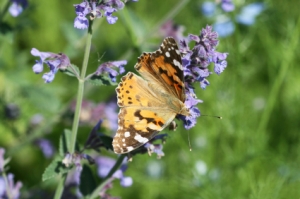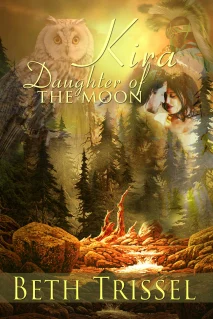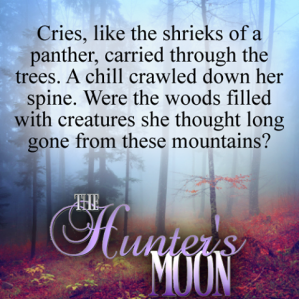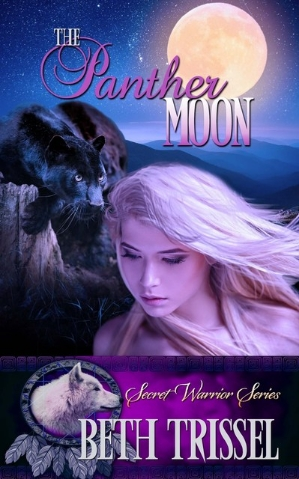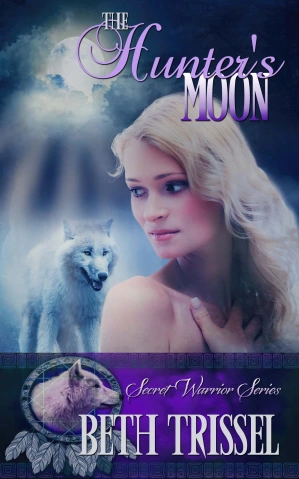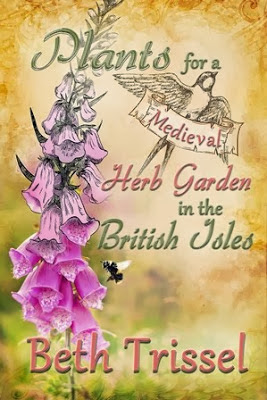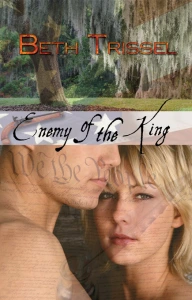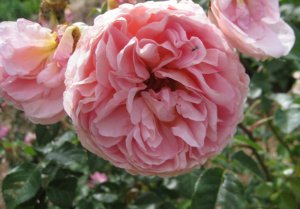“My little bit of earth in the front garden is one of the places that I find my bearings. The rhythm of my day begins with a cup of coffee and a little bit of weeding or dreaming.” ~Betsy Cañas Garmon, http://www.wildthymecreative.com
 (Foxglove and roses in my Memorial Garden)
(Foxglove and roses in my Memorial Garden)
Living on a farm allows me more than a bit of earth, but the garden is also where I find my bearings. As much as I savor fresh fruits and vegetables, it’s the flowers that feed my soul. Beds dating back to my late mother-in-law’s day wrap this old white farm house and flow along the side of the road where drivers roar past. The road wasn’t such a menace in Mom Trissel’s time. Now, it’s ‘gardener beware’. I’ve reeled back more than once while working in that bed when a driver zoomed by alarmingly close. I have this crazy hope they will slow down to admire the flowers. Plus the barnyard geese graze in my front yard and sometimes wander near the road. We have about two dozen squawky Pilgrim geese. We’d have even more but they aren’t great parents and often misplace goslings. We’ve rescued some babies but can only do so much. It’s a running joke about the geese hating me, while not minding Hubby Dennis or daughter Elise. I think it’s because I clap and shout to get them away from the road and out of my yard. In addition to grass they graze on my plants, like phlox and bee balm. Tender lettuce is also a favorite but the vegetable plot is fenced in. Pic of goose with the monarch was taken last summer. Those are tithonia flowers the butterflies love.
Below are Shirley Poppies, Larkspur, yellow evening primrose, roses, iris, yellow coreopsis, and blue Love in the Mist blooming now in that massive bed along the road. A giant old-fashioned rose commands the far corner. This sea of color overflows with wildflowers, perennials, heirloom flowers, roses, and herbs. The abundant plants are so thick there is little need for mulch. It’s my living barrier to that beastly road. Grandchildren also play in the yard, but on this side of the border. The kids love to explore the many beds that comprise my garden, but they aren’t allowed to stick a toe in that one. Only I risk life and limb.
I’ve whittled down the vegetable plot over the years and expanded Mom Trissel’s flower beds while adding others. Herbs and blossoms surround my vegetable garden and mingle with the edibles. Drifts of wildflowers I seeded in April are lush with promise but I’ve knocked myself out dragging the hose around during dry spells. Blooms fill our small back garden from the white snowdrops in late winter to pink Queen Charlotte anemone in late summer. I watch from the kitchen window as feathered friends visit the bird feeder and hummers dart. Because this garden is enclosed by a wall, I can only expand it so far. Aggressive plants like fragrant Egyptian mint and Queen Anne’s Lace have taken too much ground, though both are beautiful. The mint should have been planted in a pot but I didn’t know that thirty years ago. Battling mint is an ongoing struggle and I must thin Queen Anne’s Lace. Iris and Dame’s Rocket (below) are finishing up for this season, as are Mom Trissel’s peonies. I moved some of her peonies and iris to the kitchen and Memorial gardens. My dear grandmother gave me this white iris years ago.
Dear to my heart is the expansive Memorial Garden I’ve labored in since late February. Not only have I worked there every day the weather permitted, but often when it didn’t. Cold wind blasted me in my scarf and multiple layers. Raw drizzle misted my face and chilled my muddy gloved fingers. In the early days, if temps hit the upper forties, I headed out the door. Fifties was a heat wave. Sometimes I waited until mid-day for the ground to thaw enough to dig. Everything was brown and depressing at first, apart from emerging daffodils. The only beauty lay in my vision of what could be. But I was bent on digging out wild asters that had overrun this enormous bed and creating a glorious site. I still dig tenacious roots out daily, but I’ve left some asters growing along the fence. They are butterfly magnets. The colorful mounds, some reaching over six feet tall, flutter and buzz with life in late summer. If I’m not careful, though, that’s all I’ll have. And I badly needed a goal and physical work this spring.
 (Me digging aster roots. Hubby took pics when I didn’t realize)
(Me digging aster roots. Hubby took pics when I didn’t realize)
I spent hours crawling around in the bleak cold getting out roots. See the tiny plant surrounded by stones? It’s a poor little rose that got lost in the asters, much happier since its rescue. Asters pictured below.

“Gardening is a matter of your enthusiasm holding up until your back gets used to it.” ~Author Unknown (Truth! My back ached terribly in those first days,not much now.)
“I cultivate my garden, and my garden cultivates me.” ~Robert Brault, rbrault.blogspot.com
The garden has, indeed, cared for me. My father’s passing in late December, only a year and a half after my brother Chad’s death, left me overwhelmed with grief. Then my mother-in-law died. The Memorial bed is also for her. All the digging, clean up, planting, mulching, path making, and ongoing planning for what to put in where has given me a much needed focus. Writing eluded me as I never thought it would. But nature hasn’t. And Lord knows the seed catalogues and online garden sites are there for me. Local ones, too. I have discovered some wonderful gardeners through the world of YouTube. My favorite is artist Jeri Landers. the Storybook Gardener, who has been of much comfort and inspiration. I love her creativity and gardening style and avidly follow her YouTube channel.
Like Jeri, I would describe my garden as cottage, country, with native plants. I’m not in the least formal. In one video, Jeri suggested finding an unsightly–even ugly–corner and making it beautiful. So I tackled the kitchen garden, another bed ruled by an overreaching plant, Bishop’s Weed. It was a hard slog, but I am delighted with the transformation. Then I took on a third bed overrun with a different kind of wild aster, and so on…You see the pattern here. I worked until I dropped, but it helped lift my spirits.
Jeri raised stunning foxglove from seed this year, while I bought plants, so guess what seed I ordered yesterday…plus, plus. I have a little greenhouse Dennis built for me eons ago, but it relies on solar heat. Too often seeds I sow in spring don’t germinate, even with a heating mat. I like Jeri’s idea of starting some of the hardy flowers in summer and wintering them over to bloom next year.
My most enticing plant lure are roses. At last count, I’ve moved four from various corners of the yard where they weren’t thriving to join five existing roses in my Memorial Garden. Two more roses were given to me, and I’ve purchased fourteen. So far. You can’t have a remembrance garden without the queen of flowers. Most came from English rose breeder David Austin and Jackson and Perkins. (J and P had a super sale this past week.) Several roses spilled into my newly reclaimed kitchen garden. I eagerly await those that have not yet bloomed. Among my new Memorial Garden additions are delphiniums, various buddleias, oriental lilies, gladiolas, hollyhocks, sweet William, iris, peonies, hardy geraniums, dianthus, bellflowers, less aggressive perennial asters and an annual aster, heuchera (coral bells) Lady’s Mantle, phlox, yarrow, saliva, rudbeckia, violas, columbine, different varieties of poppies, foxglove, lupins, verbena, catmint, sweet alyssum, lavender, chamomile, lemon marigolds… I’m still adding. Pics below from emerging blooms in that garden: roses, nepeta (catmint) miniature delphinium and violas. I started violas and alyssum from seed.
 Carding Mill — David Austen Rose
Carding Mill — David Austen Rose
Grief has its own timetable, with unpredictable ups and downs, as uncontrollable as the tide. I’m slowly finding my way, but know the sadness will never fully leave me. I already knew this from past grief, but never quite so sharply. I’m blessed with a close loving family and dear friends. They are my lifelines. I hope to find my way back to writing. This is the most I’ve written in months and it hasn’t been easy, but cathartic. For me, gardening is a vital part of healing. At some point, I will add a plaque, statue, or remembrance stone to the Memorial garden. Maybe all three. It’s a work in progress.
“I think this is what hooks one to gardening: it is the closest one can come to being present at creation.” ~Phyllis Theroux
First hollyhocks opened yesterday.

























